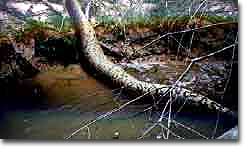 |
||||||||||||||
 |
||||||||||||||
 |
||||||||||||||
 |
||||||||||||||
| The mode of transportation, as we travelled up the Manupare (from Puerto Araona to Palmasola), was a long wooden canoe that required a full time bailing effort to keep the rivers muddy water at bay. The boats propeller was mounted at the end of a shaft about 10 feet long in the way of the river runners. | ||||||||||||||
| Travelling 6 to 8 hours, depending on the direction of the current and the reliability of the motor, could be considered a full days work. Ten hunting camps were identified ,by the Araona guides, between Puerto Araona and Palmasola. Using GPS we identified their precise location. |  |
|||||||||||||
 |
Araona hunters and their catch - a Tapir, which can weigh up to 300 kg. | |||||||||||||
 |
 |
 |
||||||||||||
| A wide range of soil profiles are exposed along the Rio Manupare. Including this one, which clearly shows leaching in the top part of the profile. From the coloration of the soils it appears that a rich history of sedimentation in the Amazon basin is embodied in the soils. | ||||||||||||||
| The only snake we saw during the trip was this huge deceased Anaconda which lay half submerged on the bank of the Manupare - a big morsel in the food chain of the forest. If the snake was alive and lurking it would be interesting to see the reactions of the humans in the boat. The Anaconda is a nocturnal predator of the Amazon. The Araona eat birds, monkey and tapir but will not eat the giant snakes.
ANACONDA LINKS |
||||||||||||||
 |
||||||||||||||
 |
||||||||||||||
| This is the 'dock' at Palmasola which doubled as the bathtub for the crater team and the native children to refresh the spirits and remove the grime from sweaty bodies. The Manupare's brown and muddy appearence (caused by suspended sediment) did not deter us when we were thirsty. However, we would drink the river water only after we dissolved iodine tablets in the murky liquid. | ||||||||||||||
 |
||||||||||||||